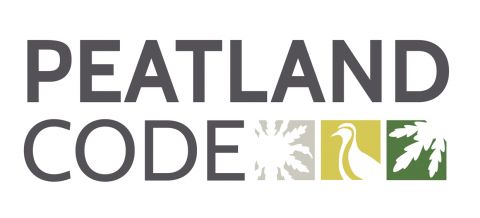
The Peatland Code is a voluntary certification standard for UK peatland projects wishing to market the climate benefits of peatland restoration and provides assurances to voluntary carbon market buyers that the climate benefits being sold are real, quantifiable, additional and permanent.
Why is the Peatland Code needed?
A significant barrier to peatland restoration is financial with current public funding being both limited and competitive. To make peatland restoration economically attractive additional funding sources are required. One such source of funding is the sale of ecosystem services, such as climate benefit. To access these voluntary carbon markets buyers, need to be given assurance that the climate benefits being sold are real, quantifiable, additional and permanent.
The Peatland Code is the mechanism through which such assurances can be given.
Peatlands are naturally waterlogged systems. This slows down decomposition and enables plant remains, containing carbon removed from the atmosphere by photosynthesis, to be laid down as peat. As a result, peatlands in their natural state accumulate carbon, in the form of peat, at a rate of approximately 1mm a year. It is this long-term carbon storage that sets peatlands apart from other ecosystems.
The majority of the UK’s peatlands, however, are no longer sequestering and storing carbon. As a result of decades of unsuitable land management practices, it has instead become a significant net source of Greenhouse Gases (GHG) currently emitting approximately 16 million tonnes of carbon dioxide equivalent (CO2e) each year. This is equivalent to around half of all the reduction efforts made annually in the UK. Preventing further damage and restoring healthy ecosystem function can therefore play an important role in climate regulation within the UK. Conserving and restoring peatlands also prevents loss of biodiversity and helps to enhance water quality.
How does the Peatland Code work?
The Peatland Code sets out a series of best practice requirements including a standard method for quantification of GHG benefit. Independent validation to this standard provides assurance and clarity for buyers with regards the quantity, quality of emissions reductions purchased. Recognising that carbon benefits arise for many years after the initial restoration activities are implemented, the Peatland Code also ensures the carbon benefit will be regularly measured and monitored over the lifetime of the project (minimum 30 years). Buyers can therefore be confident in purchasing peatland carbon units upfront, enabling the restoration project to take place.
Funding obtained from the sale of climate benefit can sit alongside traditional public sources of funding, providing cost effective peatland restoration and ensuring management and maintenance of restoration projects over the long term.
The Peatland Code is currently designed to attract private purchases motivated by corporate social responsibility. The funding received from the sale of carbon benefit will depend on the extent of damage prior to restoration, the size of the project and the length of the management agreement. The wider associated ecosystem service benefits of restoration (improvement in biodiversity, cleaner water, water flow management) may also become a unique selling point of the project.
The Peatland Code works for everyone involved:
- Carbon buyers have reassurance that they have facilitated a responsible scheme, which will result in additional climate benefits
- Projects have recognised procedures and standards to work to, and can use their validated/verified status as a means to market the carbon benefits to potential buyers
- Society will benefit from enhanced climate mitigation and the restoration of the natural landscape.
Leaflets on the Peatland Code
- Creating Peatland Restoration Projects highlights the benefits landowners can receive from registering projects under the Peatland Code, eligibility criteria and the process for becoming a Peatland Code certified project.
- Unlocking Private Finance provides an overview of the complications facing damaged peatlands and how landowners can receive private financial investment through carbon finance.
- Buying Carbon Units explains what carbon units are, how you buy them and the benefits for buyers.
Contact
Dr Renée Kerkvliet-Hermans
IUCN UK Peatland Programme, Peatland Code Coordinator
Email: renee.kerkvliet-hermans@iucn.org.uk
Ed Salter
IUCN UK Peatland Programme, Peatland Code Officer
Email: ed.salter@iucn.org.uk
Tel: +44 (0) 7423642489
or alternatively email: peatlandcode@iucn.org.uk
Garance Wood-Moulin
IUCN UK Peatland Programme, Peatland Code Development Manager
Email: gwmoulin@iucn.org.uk
Tel: +44 (0) 1636670108
or alternatively email: peatlandcode@iucn.org.uk










